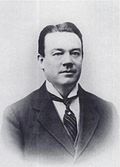Results
The Nationalist Party ran in this election, having not contested the previous election in 1924. It regained the two seats in Fermanagh and Tyrone it had held from 1922 to 1924.
In the election as a whole, the Conservative Party, which included the Ulster Unionists, led by Stanley Baldwin, lost its majority and the Labour Party formed a minority government with Ramsay MacDonald as Prime Minister.
| 1929 United Kingdom general election in Northern Ireland [1] [2] |
|---|
|
|---|
| Party | Candidates | Votes |
|---|
| Stood | Elected | Gained | Unseated | Net | % of total | % | No. | Net % |
|---|
| | UUP | 13 | 11 [a] | 0 | 2 | -2 | 84.6 | 68.0 | 247,291 | -15.8 |
|---|
| | Liberal | 6 | 0 | 0 | 0 | 0 | — | 16.8 | 61,192 | +16.8 |
|---|
| | Ind. Unionist | 2 | 0 | 0 | 0 | 0 | — | 6.9 | 25,057 | +6.7 |
|---|
| | Nationalist | 3 | 2 [b] | 2 | 0 | +2 | 15.4 | 6.6 | 24,177 | +15.4 |
|---|
| | Sinn Féin | 0 | 0 | 0 | 0 | 0 | — | — | — | -9.9 |
|---|
| | NI Labour | 0 | 0 | 0 | 0 | 0 | — | — | — | -6.1 |
|---|
Votes in constituencies using the bloc voting system are counted as 0.5 each, as each voter had one vote per seat.
This page is based on this
Wikipedia article Text is available under the
CC BY-SA 4.0 license; additional terms may apply.
Images, videos and audio are available under their respective licenses.

